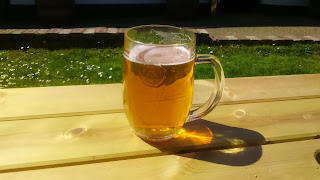 |
| Festival overview |
A spokesman for the group said, "The whole thing is about promoting Tonbridge as a great food location. We have this ambition to make Tonbridge like a modern market town." He added that, “Town traders and borough producers were the team's priority, but businesses from throughout the south-east would be invited to ensure there was something for everyone.” The event’s aim was to bring in people from across the district and south-east London to see what Tonbridge has to offer.
 |
| The River Medway approaching Town Lock |
Come Sunday afternoon I decided it was time to show my support for the event and take a look at the Festival. Consequently I cycled down to the Castle, after a quick detour along the bank of the River Medway, primarily to take a look at recent improvements carried out around the Town Lock area.
The event was in full swing when I arrived, and was busy; mainly with families. After a quick peruse of the beer tent, and deciding to give it a miss because of the lengthy queue, and plastic glasses, I made my way along the aisles to see what was on offer at the various stalls. Despite the publicity, there didn’t seem to be many local traders present.
 |
| Aptly named? |
I did see a stall selling cider, but the only beer I saw, apart from the bar, was a stand selling bottled beers under the banner, “Giving Good Beer a Bad Name”. With juvenile names such as Old Fart, Grumpy Git, Cat Pee and Big Cock, this seemed little more than a novelty (and a rather poor one at that), designed to part people from their hard earned cash; although at £4.50 a bottle, the stall unsurprisingly wasn’t doing a lot of business! At least the people behind this were honest with their banner, but gimmicks like this have as much appeal as the poor-taste sexist and xenophobic T-shirts which used to be on sale at GBBF. The company has its own website; which you can check out here, but there is no indication as to who actually brews the beers.
 |
| Gatehouse - Tonbridge Castle |
Footnote: I may have come across as rather churlish and somewhat
dismissive of the Tonbridge Food & Drink Festival, but only because we have
been spoilt here in Tonbridge by the town’s excellent Farmers’ Market, which takes place on the
second Sunday of each month. Here, you will find a much wider range of local
produce ranging from organically-raised meat to vodkas flavoured with locally-grown
fruit. There is at least one cider stall, plus Sussex
brewers, Hepworths, normally have a stall. I usually buy sufficient stock of
their excellent bottled Old Ale to see me through the winter, but their entire
range of bottles is normally available.
I would imagine that given this is the first such event, the
organisers of Tonbridge Food & Drink Festival will have taken note of what
worked and what didn’t, and that next year’s event will see a few changes and an overall improvement.
Full marks though to Tonbridge Town Team for their vision and determination in
getting this year’s festival off the ground.
























